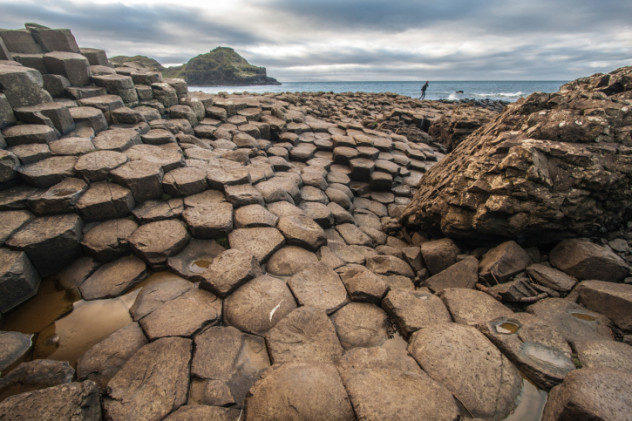 Animals
Animals  Animals
Animals  Weird Stuff
Weird Stuff 10 Weird Things That Warp Your Sense of Time
 Miscellaneous
Miscellaneous Ten More Extremely Unexpected U.S. State “Firsts”
 Humans
Humans 10 Ideas That Scare People to Death
 Music
Music The Cursed Decade: 10 Classic Rock Stars Who Had Low Periods in the 1980s
 Health
Health 10 Crazy Ways Sleep Deprivation Can Affect You
 History
History 10 Enthralling Facts about the Field of Cloth of Gold
 Pop Culture
Pop Culture The Ten Greatest Engineers in Science Fiction History
 Humans
Humans Ten Journalists Who Got Caught Faking the News
 Travel
Travel 10 Best Hiking Trails in America with Breathtaking Views
 Animals
Animals Ten Animals That Produce and Store Toxins in Unlikely Places
 Weird Stuff
Weird Stuff 10 Weird Things That Warp Your Sense of Time
 Miscellaneous
Miscellaneous Ten More Extremely Unexpected U.S. State “Firsts”
Who's Behind Listverse?

Jamie Frater
Head Editor
Jamie founded Listverse due to an insatiable desire to share fascinating, obscure, and bizarre facts. He has been a guest speaker on numerous national radio and television stations and is a five time published author.
More About Us Humans
Humans 10 Ideas That Scare People to Death
 Music
Music The Cursed Decade: 10 Classic Rock Stars Who Had Low Periods in the 1980s
 Health
Health 10 Crazy Ways Sleep Deprivation Can Affect You
 History
History 10 Enthralling Facts about the Field of Cloth of Gold
 Pop Culture
Pop Culture The Ten Greatest Engineers in Science Fiction History
 Humans
Humans Ten Journalists Who Got Caught Faking the News
 Travel
Travel 10 Best Hiking Trails in America with Breathtaking Views
10 Famous Landmarks Surrounded By Legends
Sometimes the truth is stranger than fiction. But it seems that people will always prefer myth and mystery over the truth. Legends evoke a sense of wonder and fascination, especially when they mention famous places or even people. On this list are 10 famous landmarks surrounded by awesome legends.
10The Sphinx

Some of the only facts agreed upon by experts regarding the Great Sphinx of Giza are that it is one of the biggest and most ancient statues in the world and that it has the body of a lion and the head of a man resembling an Egyptian pharaoh. The rest all comes down to speculation and legend.
One of the most retold legends of the Sphinx is the one about a prince of Egypt, known as Prince Thutmose. The prince’s grandfather was Thutmose III who descended from Queen Hatshepsut. According to the legend, Prince Thutmose was the apple of his father’s eye, making him the target of extreme jealousy when it came to his siblings. Some even plotted to murder him.
Because of the turmoil in his personal life, Thutmose preferred to be away from home and started spending a lot of time in upper Egypt and the desert. Being a strong and skilled man, he enjoyed hunting and archery. One particular day during a hunt, Thutmose left his two servants behind in the heat of the day to go say his prayers near the pyramids.
He paused in front of the Sphinx, known in those days as Harmachis—god of the rising sun. The massive stone statue was up to its shoulders in desert sand. Thutmose stared up at the Sphinx, praying that it would take away all his problems. Suddenly, the great big statue seemed to come to life and a loud voice sounded up from it.
The Sphinx beseeched Thutmose to release it from the sand that was weighing it down. As it spoke, the Sphinx’s eyes grew so bright that as Thutmose looked into them he couldn’t bear it and fainted. When he woke, the day had already started growing long. Thutmose rose slowly and then made an oath to the Sphinx as he stood before it. He promised that if he became the next Pharaoh, he would rid the Sphinx of all the sand covering it and immortalize the event in stone. He went on to do exactly this.
As all good legends would have it, Thutmose indeed became the next ruler of Egypt, his problems long left behind him. The story gained notoriety as little as 150 years ago when an archaeologist cleared away the sand from the Sphinx and found a stone tablet between its paws describing the story of Prince Thutmose and the oath he made to the great Sphinx of Giza.
9The Great Wall Of China

A tragic romance is just one of the many legends associated with the Great Wall of China. The story of Meng Jiangnu is one of the most infamous tales and heartbreaking right from the start. It is said that a man and woman with the family name of Meng lived next to another couple who went by the family name of Jiang. Both of these couples were very happy, but neither had children. As the years went by, the Meng couple decided to plant a gourd vine. The vine grew successfully and ended up sprouting a gourd on the property of the Jiang couple.
Having been friends for a long time, the two couples decided to share the gourd. To their absolute amazement, when they split the gourd in the middle they found a baby inside it. It was a beautiful little girl. Just as with everything else, the two amazed couples decided they would share the upbringing of the little baby. They called her Meng Jiangnu.
Meng Jiangnu grew up to be a very beautiful young woman. She married a young man named Fan Xiliang after finding him hiding away from officials who were trying to force young men to start building the Great Wall. However, he couldn’t hide forever, and a mere three days after they wed, Xiliang was taken away to help others with the construction of the wall.
Meng was alone for an entire year, having received no news of progress on the wall nor of her husband’s well-being. After having a disturbing nightmare about Xiliang, Meng decided she couldn’t bear the silence anymore and went looking for him. After a long journey that saw her trawling through rivers and climbing hills and mountains, Meng reached the wall only to hear that Xiliang died of pure exhaustion and his final resting place was underneath the wall.
Meng could not control her grief and, after crying for three days straight, the part of the wall she was next to crumbled and collapsed. The emperor at the time felt that Meng needed to be punished for damaging the wall, but once he saw her beautiful face he asked for her hand in marriage instead. She agreed but requested three things from the Emperor in return. She wished mourning for her husband Xiliang (including the emperor himself as well as his servants). She wanted a burial arranged for Xiliang, and she expressed the need to see the sea.
Meng Jiangnu never married again. After she attended the burial of Xiliang, she committed suicide by throwing herself into the ocean.
Another version of the legend says that as Meng Jiangnu cried and cried, the wall collapsed to the point where the skeletons of those workers who died were protruding from the ground below. Knowing that her husband was down there somewhere, Meng cut her fingers until they bled profusely and watched as the blood dripped over the bones of the dead. When her blood suddenly started centering around a particular skeleton and flowed into it, Meng knew she had found her husband. She then had him buried and ended her own life by jumping into the ocean.
8Forbidden City

Back in the day, you couldn’t just show up at the Forbidden City. If you did, you’d most likely have left without your head. Literally. The Forbidden City consists of several ancient building and palaces and is the largest of its kind in the world. It couldn’t be visited under Qing rule, and no one but emperors and their servants saw the inside of the city for over 500 years.
At least in modern times, visitors are allowed to explore the ancient complex and perhaps hear about some of the legends surrounding it. One such legend has it that the four watchtowers in the Forbidden City were built as the result of a dream.
Allegedly, the Forbidden City under Ming rule had only very high walls, but not a watchtower in sight. The Yongle emperor was in charge in the 15th century and, at one point, had a vivid dream about the city. In his dream, he saw fantastic watchtowers decorating the four corners of the city. When the emperor awoke from his dream, he immediately set his builders to task to transform the dream into reality.
The tale goes on to say that after a failed attempt by two sets of builders (and their eventual execution by beheading), the master builder of the third set of builders was very nervous about taking on the job. However, after modeling the watchtowers after a grasshopper cage he had seen, the emperor could not be happier.
The master builder also took care to include the number nine in the design of the building in order to please the emperor even more. The number nine is said to represent emperors. Also, the old man selling the grasshopper cages that inspired the master builder of the watchtowers was said to be Lu Ban, who just happened to be the grandfather of all Chinese carpenters.
7Niagara Falls

The legend of “The Maiden Of The Mist” may have been the inspiration for a boat ride being launched with the same name at Niagara Falls. This legend, as is the case with most legends, has many different versions.
The most well-known one, however, tells of a Native girl named Lelawala who was offered to the gods in order to appease and please them. The offering came in the form of the girl being thrown down Niagara Falls. One of the original legends states that Lelawala was out in a canoe when she was swept down the waterfall by accident.
She was then rescued from certain death by the thunder god named Hinum, who afterward gave her a lesson in defeating the huge monstrous snake that inhabited the river. She relayed the message to her village, with the people then declaring war against the snake. Many believed that the fighting that ensued caused the Niagara Falls to form in the way it is seen today.
Misdirected versions of this legend have been in print since the 17th century, with many blaming the several flaws on one Robert Cavelier de La Salle, who was an explorer from Europe. Robert made fantastic claims such as that he visited the Haudenosaunee people and witnessed the chief’s virgin daughter being sacrificed, with the chief falling victim to his own conscience at the very last minute and then falling to his own death alongside her. The daughter, Lelawala, then became “The Maid of the Mist.”
However, Robert’s own wife turned against him and accused him of depicting the Haudenosaunee people as ignorant so that he could take their land from them.
6Devil’s Peak And Table Mountain

Devil’s Peak is one of the most infamous mountain spires in South Africa. And it has a great legend to tell (so to speak) every time fog rolls in from the ocean and covers it along with Table Mountain. Capetonians and others from around South Africa still relay the tale to their children and grandchildren.
It is said that a pipe-smoking pirate by the name of Jan van Hunks settled in the Cape in the 1700s, eager to leave his pirating ways behind him. He married and then found himself a house at the foot of the mountain. His wife hated his pipe-smoking habit and would chase him out of the house whenever he lit his pipe.
Van Hunks got into the habit of going some ways up the mountain and then finding a good spot to smoke in peace. On a perfectly normal day, van Hunks started up the mountain again only to find a strange man sitting on his usual spot. He couldn’t see the man’s face as he was wearing a very large hat and was dressed in all black.
Before van Hunks could say anything, the stranger greeted him by name. Van Hunks then sat down next to the man, and they started up a conversation that inevitably led to Jan’s smoking habit. Jan van Hunks liked to boast about the amount of tobacco he could handle, and he did so with the stranger as well after he asked van Hunks for some tobacco.
The stranger mentioned to van Hunks that he could very easily smoke more than the pirate could, and this immediately led van Hunks to challenge him in proving who could smoke the longest without getting sick.
With massive plumes of smoke surrounding the two men and much of the mountain, the stranger suddenly became agitated and couldn’t go on smoking. As his hat fell from his head, van Hunks suddenly gasped. He was facing the Devil himself. Being very annoyed that a mere mortal had showed him up, the Devil snatched both himself and van Hunks away in a lightning flash to an unknown destination.
Now, every time fog rolls over Devil’s Peak and Table Mountain, it is said that van Hunks and the Devil have retaken their spots on the mountain and are gearing up for another go at the smoking competition.
5Mount Etna

Mount Etna, located on the eastern coast of Sicily, is one of the highest and most active volcanoes in Europe. The first recorded eruption occurred in 1500 B.C., and the volcano has erupted at least 200 times since then. In a single eruption that lasted four months in 1669, the lava covered 12 villages and destroyed surrounding areas.
Greek legend has it that the eruptions are caused by none other than a 100-headed monster (the heads resemble dragon heads) that spews massive fire columns from one of its heads when it becomes angry. Apparently, this huge monster was known as Typhon and was the son of Gaia, the goddess of Earth. Typhon became quite the rebellious kid and was then banned by Zeus to live under Mount Etna. So, every now and then, his anger takes the form of boiling hot lava that shoots into the sky.
Another version has a terrible one-eyed monster known as Cyclops that lived inside the mountain. Odysseus was sent to battle the monster and he managed to reach Cyclops even though the monster threw huge boulders at him from the top of the mountain. Odysseus also managed to defeat Cyclops by lancing him in his only eye sending him into the depths of the mountain. The legend further states that the Mount Etna crater is actually the damaged eye of Cyclops and the lava spewing forth from it is the flowing blood of the monster.
4Avenue Of Baobabs

It is not just the lemurs in Madagascar that make the island resonate with people around the world. The island’s main claim to fame is the breathtaking Avenue of Baobabs situated in its western part. Known as the “mother of the forest,” 25 massive baobab trees line a dirt road on the island. They are indigenous to Madagascar and also the largest of the baobab trees. Naturally, their strange appearance has paved the way for legends and myths aplenty.
One of the legends surrounding the Avenue of Baobabs is that the trees kept running off while God was making them, so God decided to plant them upside-down. This would explain their root-like branches. Others tell a different story. Apparently, baobabs started out as really magnificently beautiful trees. However, they became so full of themselves and bragged so much about their beauty that God promptly turned them upside-down so only their roots would show. It is also said that, for this reason, baobabs only have flowers and leaves for a couple of weeks every year.
Legend or not, six of the baobab species belong in Madagascar alone. However, deforestation poses a serious threat even amid all the conservation and reforestation efforts implemented there. If more isn’t done to protect them, the subjects of these legends will disappear, likely forever.
3Giant’s Causeway

Picking a fight with a giant led to the inadvertent creation of the Giant’s Causeway, located in northern Ireland. Or so legend would have you believe, anyway. Whereas scientists believe that the perfectly formed hexagonal basalt columns are the result of 60 million years worth of lava, the legend of Benandonner the Scottish giant is a little more entertaining.
The legend tells of Irish giant Finn McCool, who had a long-standing feud with Scottish giant Benandonner. On one particular day, the two giants were yelling at each other over the Sea of Moyle when McCool became so enraged he grabbed a handful of earth and tossed it at the Scottish giant. The clump of earth landed in the sea and is now known as the Isle of Man while the spot where McCool dug into the ground is known as Lough Neagh.
The feud grew between the two giants and Finn McCool decided to build a causeway for the Benandonner to reach him since the Scottish giant couldn’t swim. This way they could have a real fight and see who was the bigger giant. After spending some time on building the causeway, Finn was tired and he fell asleep easily.
At some point while he was sleeping, Finn’s wife heard extremely loud thundering sounds outside and she realized she was hearing Benandonner’s footsteps coming closer and closer. When the Scottish giant reached the couple’s house, Finn’s wife immediately saw that Benandonner would spell the end for her husband as he was much bigger than Finn. Thinking fast, she wrapped a massive blanket around Finn and placed the biggest bonnet she could find on his head. Then she opened the front door.
Benandonner yelled into the house for Finn to come out, but the woman shushed him, warning that her “baby” would wake up. Legend has it that when Benandonner saw the size of the “baby,” he didn’t care to stick around to see the size of its father. He swiftly ran back to his own home, destroying some of the causeway as he went along, so that no one could go after him.
2Mount Fuji

Mount Fuji is a massive volcano located in Japan. It is not only a huge landmark, but it has become intertwined with Japanese culture, so much so that it is the subject of many songs, movies, and of course, legends and myths. In what is believed to be the oldest story originating from Japan, an explanation is also given for the fires of Mount Fuji.
A bamboo cutter was going about his daily task when he stumbled across something very strange and unusual. A tiny baby no bigger than his own thumb was gazing up at him from inside the bamboo he was busy cutting. Seeing how beautiful the tiny baby was, he took her home to his wife so that they could raise her as their own.
Soon after, the bamboo cutter started making more discoveries while working. Every time he cut a piece of bamboo, he found a gold nugget inside it. After a short while, the bamboo cutter and his family were very rich. The little girl grew into a stunning young woman. The bamboo cutter and his wife had learned in the meantime that the girl named Kaguya-hime was sent from the Moon to Earth so that she would be protected from a war raging there.
Because of her beauty, Kaguya-hime had several marriage proposals, even from the emperor, but she declined all of them in her quest to get back home to the Moon. When her own Moon people finally came to take her home, the emperor was so distressed at the prospect of losing her that he sent his own men to fight Kaguya-hime’s true family. However, a blinding light sent them reeling.
As a parting gift, Kaguya-hime (the Moon princess) sent the emperor a special letter and an immortality elixir which he refused to drink. He, in turn, wrote her a letter and requested that his men take it to the highest peak in all of Japan and burn it and the elixir together on it, in the hopes of it reaching the Moon.
However, all that happened when they burned the letter and the elixir on Mount Fuji is that the fire they started could not be extinguished. And this is, according to legend, how Mount Fuji became a volcano.
1Yosemite

Half Dome at Yosemite is a major challenge when it comes to hiking, but hikers and rock climbers absolutely love it. When the Native Americans lived close to Half Dome, they named it Cleft Rock. At some point due to the repetitive thawing and freezing of the rock, a large chunk of it fell away, which gave it the look it has today.
The origin of Half Dome has been the subject of a great legend still being told today: the legend of Tis-sa-ack. The tale also seeks to explain the strange silhouette of what looks like a face that can be seen on the side of Half Dome.
The legend tells of an old Native woman and her husband who made the journey to a valley called Ahwahnee. All the while, the woman carried a heavy basket made from grass and reeds while her husband simply swung his walking stick around. This was tradition in those days, and no one would have thought it strange that the husband didn’t offer to carry the basket.
The woman, called Tis-sa-ack, was very thirsty by the time they reached the lake at the mountain because of her heavy burden and the hot sun beating down on her. Therefore, she wasted no time in rushing to the lake and drinking gulping mouthfuls of the water.
To her husband’s dismay, he found that his wife had drunk so much that the entire lake had dried up by the time he got there. And things got worse from that point on. Due to the lack of water, a drought struck the area and all things green withered away. Her husband was so angry that he picked up his walking stick and aimed to strike Tis-sa-ack.
She burst into tears and started running away from him, her basket in her hands. She turned around at one point and threw the basket at him so that she could get away. It was as she looked at him that the Great Spirit residing in the valley turned them both into stone.
Today, they are known as Half Dome and Washington Column. It is said that if you look closely at Half Dome you can see the woman’s face on it, her tears still flowing silently.
Estelle lives in Johannesburg, South Africa. She loves myths and legends of all kinds. She also kinda wishes giants were still around because of their sheer awesomeness.








